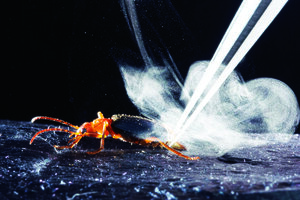Can noxious beetle bursts make better engines?
Bombardier beetles engage in some serious chemical warfare – and for the first time, researchers understand exactly how.

Photograph of bombardier beetle spray ejection.
Charles Hedgcock, (c) 2015 Wendy Moore
For a tiny creature, the bombardier beetle packs a big punch.
When threatened, these insects shoot a superheated chemical spray, a minor discomfort to unsuspecting humans, but an almost certain death for attacking ants.
The bombardier beetle’s defensive spray is a product of near-instantaneous chemical explosions from within the body; until now, it had only been observed externally. But with the help of x-ray imaging, researchers were finally able to study this incredible mechanism properly – in real-time, from the inside out. A new study, published today in Science, explains how the bombardier beetle’s defensive glands produce and endure these consecutive explosions.
With some 1,400 known species on nearly every continent, bombardier beetles average less than an inch in length. MIT doctoral candidate and lead author Eric Arndt zeroed in on the brachinines – bombardier beetles in the subfamily Brachininae – for their unique properties. Brachinines produce hotter and faster toxic sprays than their close relatives. Ultimately, Mr. Arndt and his colleagues settled on Brachinus elongatulus, whose sprays are pulsating, rather than continuous.
The powerful defense of B. elongatulus works a little bit like a chemical heat pack. A pair of glands, each with two compartments, contain the ingredients for the spray. The inner compartment is a flexible sac containing hydrogen peroxide, water, and chemical compounds called hydroquinones. The other compartment is stiffer and contains enzymatic peroxidase. A valve divides the two chambers, preventing their contents from mixing together.
But when an individual is threatened, it contracts the muscles surrounding the reservoir, allowing reactive solution into the enzyme chamber. This triggers an exothermic reaction that heats the mixture to about 100 degrees Celsius, boiling off a third of the water and spewing out toxic vapor in the process.
“This happens explosively,” Arndt says. “If you look at the video, it all happens in a single frame. If you do the math, it takes even less than that – about 10 milliseconds.”
Through synchrotron X-ray imaging, Arndt and his colleagues were able to watch this process occur within the bodies of these insects. To their surprise, they saw the vapor expand outside the extent of the glands. This meant that the reaction chamber – once thought to be uniformly stiff – was actually rather flexible.
As this flexible region expands, it closes off the valve, thus automatically stopping the flow of toxic vapor. And as the chamber deflates, it allows the valve to open again and produce a fresh blast.
The bombardier beetle’s highly efficient defense could find support in biomimetics – the imitation of natural models to solve human problems. Perhaps this mechanism could potentially inspire new and improved technologies, like better fuel injectors for combustion engines.
“An interesting way of looking at this mechanism is that it uses chemical processes to do work,” Arndt says. “If you look at an automobile engine, there are hundreds of parts. This is a single part that uses chemical energy to do work without all those added parts.”
“The elegance of this mechanism is remarkable,” Arndt adds. “It turns out that insects are excellent material scientists.”

